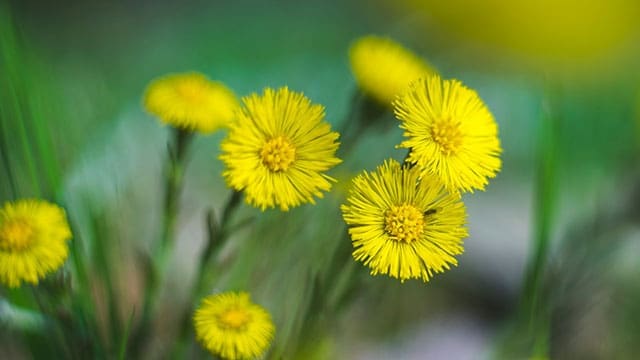Coltsfoot plant has many traditional medicinal uses including as an antihistamine and an expectorant for coughs and sore throats
 As spring awakens and we venture outside, one of the first signs of spring we notice is a tiny yellow flower along the roadsides and trails. It looks a bit like a dandelion – but not quite.
As spring awakens and we venture outside, one of the first signs of spring we notice is a tiny yellow flower along the roadsides and trails. It looks a bit like a dandelion – but not quite.
A closer look reveals it is essentially leafless at this time of year. Dandelions have thick green foliage that lasts from May well into the fall, and they don’t start flowering until the leaves are fully grown. But this flower blooms much earlier than a dandelion, and it grows on a slender stem that can even push through snow to display its blossoming head.
We’re looking at an alien plant from Europe, North Africa and Asia that was introduced to North America in the 1920s because of its medicinal properties. Coltsfoot is now entrenched and is a permanent part of our landscape.
Its scientific name is Tussilago farfara, meaning “to toss a cough:” it has many traditional medicinal uses, including as an antihistamine and an expectorant for coughs, sore throats, bronchitis, lung congestion and sore throats. Germany has registered it as an herbal medicine for specific uses, such as controlling coughs, hoarseness, and inflammation of the throat, mouth, and respiratory tract. Used primarily in tea or syrup, extracts from the leaves have also been used to make cough drops and hard candy. In traditional medicine, in addition to the uses named above, Coltsfoot is reputed to be a treatment for flu, colds, fever, rheumatism, and gout and to soothe mucous membranes.
 Photo by Olli Kilpi |
| More Nature in a Nutshell |
| The springtime antics of birds and mammals
|
| How Dark-eyed Juncos outsmart other birds for food
|
| Nature is gearing up for another spring
|
Coltsfoot is also valuable as a source of nectar and pollen early in the season for pollinators and as a food source for various Lepidoptera (butterflies).
Despite its positive benefits, there may be a downside to its use. It may have links to liver toxicity due to the specific alkaloids it contains. However, some doctors have challenged this claim, so the risk remains uncertain. Nevertheless, doctors recommend avoiding treatments with high or prolonged doses of Coltsfoot. (Note: I am not a doctor, so if you have concerns, please do not consider this as medical advice – consult with your own doctor).
This perennial spreads through seeds and rhizomes but has an odd growth cycle. Unlike other plants where flowers come after leaves have emerged, it’s almost leafless in the spring. Instead, small flowers sprout directly from the barren gravel along roadsides and waste places. These flowers are fueled by starches stored in last year’s rhizomes, allowing for flower and seed development even when no new food is produced in the current season.
Upon closer inspection, the early spring flowers reveal small, thin leaves at the base of the stalk. After flowering, the seed head, like a dandelion, emerges and can produce up to 3,500 seeds! Similar to the dandelion, its seeds are dispersed by tiny fibres carried in the wind.
Later in the season, large, broad leaves emerge and will dominate the landscape. They are waxy in appearance on the upper surface and fuzzy on the underside. They look like a horse’s hoof, hence the plant’s name. Other interesting names for the plant include tash plant, bull’s foot, coughwood, foalswort, farfara, foal’s foot and horse’s foot.
Famers may be concerned with its spread partly because it has multiple mechanisms to propagate (seeds and rhizomes) but also because few herbicides are registered to effectively control it. It is known to thrive in corn, soybean, winter wheat, spring grain, and alfalfa stands.
Regardless of its uses, good and bad, Coltsfoot is a delightful plant to see in the spring and a welcome sight after the absence of plant life through most of the winter. Now is the perfect time to see it as it’s common at this time of year, primarily in eastern Canada and the U.S.
Geoff Carpentier is a published author, expedition guide and environmental consultant.
For interview requests, click here.
The opinions expressed by our columnists and contributors are theirs alone and do not inherently or expressly reflect the views of our publication.
© Troy Media
Troy Media is an editorial content provider to media outlets and its own hosted community news outlets across Canada.

